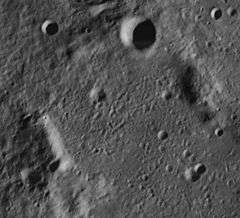Anaximander (crater)
|
Oblique Lunar Orbiter 4 image | |
| Coordinates | 66°58′N 51°26′W / 66.97°N 51.44°WCoordinates: 66°58′N 51°26′W / 66.97°N 51.44°W |
|---|---|
| Diameter | 68.71 km |
| Depth | 2.4 km |
| Colongitude | 52° at sunrise |
| Eponym | Anaximander |

Anaximander is a lunar crater that is located near the northwest limb of the Moon. It is joined at the northern rim by the crater Carpenter, a younger and better-defined formation. To the southeast is the much larger J. Herschel, a formation of the variety known as a walled plain.
The outer wall of Anaximander is heavily worn and eroded, with multiple notches and breaks. There is no central peak, but the floor contains several small craterlets and a multitude of tiny pits from minor impacts. This crater has merged with the larger Anaximander D to the south, and there is a wide break in their common rims where they have joined. To the northwest a low rise in the surface is all that separated Anaximander from the much larger satellite crater Anaximander B.
The crater is named for the 6th century BCE Greek philosopher and astronomer Anaximander.
Satellite craters
By convention these features are identified on lunar maps by placing the letter on the side of the crater midpoint that is closest to Anaximander.
| Anaximander | Latitude | Longitude | Diameter |
|---|---|---|---|
| A | 68.0° N | 50.2° W | 16 km |
| B | 67.8° N | 60.7° W | 78 km |
| D | 65.4° N | 50.1° W | 92 km |
| H | 65.2° N | 40.8° W | 9 km |
| R | 66.2° N | 54.9° W | 8 km |
| S | 68.3° N | 53.4° W | 7 km |
| T | 67.2° N | 52.0° W | 7 km |
| U | 64.1° N | 48.3° W | 8 km |
References
- Andersson, L. E.; Whitaker, E. A. (1982). NASA Catalogue of Lunar Nomenclature. NASA RP-1097.
- Blue, Jennifer (July 25, 2007). "Gazetteer of Planetary Nomenclature". USGS. Retrieved 2007-08-05.
- Bussey, B.; Spudis, P. (2004). The Clementine Atlas of the Moon. New York: Cambridge University Press. ISBN 978-0-521-81528-4.
- Cocks, Elijah E.; Cocks, Josiah C. (1995). Who's Who on the Moon: A Biographical Dictionary of Lunar Nomenclature. Tudor Publishers. ISBN 978-0-936389-27-1.
- McDowell, Jonathan (July 15, 2007). "Lunar Nomenclature". Jonathan's Space Report. Retrieved 2007-10-24.
- Menzel, D. H.; Minnaert, M.; Levin, B.; Dollfus, A.; Bell, B. (1971). "Report on Lunar Nomenclature by the Working Group of Commission 17 of the IAU". Space Science Reviews. 12 (2): 136–186. Bibcode:1971SSRv...12..136M. doi:10.1007/BF00171763.
- Moore, Patrick (2001). On the Moon. Sterling Publishing Co. ISBN 978-0-304-35469-6.
- Price, Fred W. (1988). The Moon Observer's Handbook. Cambridge University Press. ISBN 978-0-521-33500-3.
- Rükl, Antonín (1990). Atlas of the Moon. Kalmbach Books. ISBN 978-0-913135-17-4.
- Webb, Rev. T. W. (1962). Celestial Objects for Common Telescopes (6th revised ed.). Dover. ISBN 978-0-486-20917-3.
- Whitaker, Ewen A. (1999). Mapping and Naming the Moon. Cambridge University Press. ISBN 978-0-521-62248-6.
- Wlasuk, Peter T. (2000). Observing the Moon. Springer. ISBN 978-1-85233-193-1.
